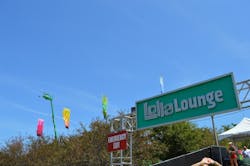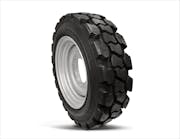Sunbelt Rentals Beats the Clock During Lollapalooza
Lollapalooza is one of the country’s longest running summer music festivals, with eight stages and 400,000 fans over four days. But before the first riff is played, Sunbelt Rentals spent nearly 10 days ensuring each festival piece was built in on time.
At the beginning of August, Sunbelt Rentals invited Construction Equipment deep inside the festival grounds as the rental giant prepared for the festival, held annually in Chicago’s Grant Park.
In total, Lollapalooza takes about three weeks for a complete setup, runs for four days of music, and takes between 10 days and two weeks for cleanup. All equipment used at the festival is sourced from about 15 locations within the Chicagoland area.
According to Mike Rosbrook, national account manager of entertainment solutions for Sunbelt, the planning process for Lollapalooza begins one year in advance, as soon as the previous festival ends.
Lollapalooza Partnership: No Room for Error
The entire Lollapalooza setup is executed through a partnership between Sunbelt and LiveNation, the events promoter and venue operator that puts on the festival every year.
The partnership has to function as a well-oiled machine in order for a show of this magnitude to work well, says the promoter, effectively hitting every timeline along the way.
“We build this show for about 400,000 people in two weeks and one day,” says Jake Perry, director of operations at C3, another entertainment group that works in conjunction with LiveNation.
“Every single minute and inch is accounted for, and if we can’t rely on our partner to hit those timelines—if you get sideways from day one—you’re going to chase that the whole way through the build.
“We know that there are going to be hiccups and delays, but it’s how you react to it. You really have to make those adjustments needed and get the personnel needed on site.”
“These gates open at 11:00, and you know it’s coming,” says Rosbrook. “These guys are on a timeline that has zero room for error; you can’t fumble anything. So when they start that Monday morning, there are 70 tractor trailers that we have to logistically help them get in here and work in conjunction with their team.”
Moving the equipment to the festival grounds is only half the battle, he says..
“If we get all the equipment delivered and it’s here, that’s great,” Rosbrook says. “But these guys cannot afford for a forklift to be broken. So if a forklift breaks down, it can take two hours to get a technician here.”
Sunbelt addresses this possible scenario by keeping technicians on site.
“We don’t have extra gear just laying around, it’s not a construction site where if you’re doing masonry and a piece of equipment goes down, they can just go over and do some electrical work for the day,” Rosbrook says. “That’s not the case here, so we have an actual technician that stays here on the site.”
Perry emphasizes availability and reliability for Lolla.
“Every single piece of equipment is being utilized to the point where we’re always asking, ‘Hey is something available right now,’ and it’s [in use],” he says. “If one forklift or manlift goes down, something is not being built, and we’re not meeting the timeline. Whether that be during the long builds, changing oil or a hydraulic hose busts, it’s mechanical. When you’ve got that many pieces of equipment on site, it’s very important.”
Setting Up Lollapalooza
Before building the stages in Grant Park, ground protection is necessary to protect the surrounding environment from cranes that execute the build.
“Since we’re building in an unorthodox setting in an unorthodox way, you’ve got to prepare a pad for these guys to not tear the turf up,” Perry says. “We put that ground protection down while they’re building the stage, our guys will come back in, we’ll tear all the ground protection out, store it behind the stages. Then on Monday morning the cranes come in and take it all back down.”
This year, four inches of rain fell during the five setup days, so it was “pretty beat down” before putting the crane pad on it, Perry says.
“The crane pads really help to not make it a complete mud pit,” he says.
In addition to the crane pads, turf tires were put on all of the gear used for the build.
“The normal forklifts have standard tires on, and typically on forklifts, that’s what you’re going to have—that aggressive tire,” Rosbrook said. “With turf tires, they can take any machine onto the grass, and it doesn't tear it up. This allows guys to build the stages without using ground protection, or tearing up the turf.”
With inclement weather also comes work stops. If lightning strikes within eight miles of the festival site, the typical protocol is an evacuation or a work stop.
“Multiple work stops happen every year, even multiple in a day,” Perry says. “So if we see a strike within eight miles and it’s tracking at us, we’ll do a full work stoppage, take shelter, and improve locations, and everybody just waits until we get an all clear. It’s a real bummer, especially with all the labor, it’s taking hundreds of hands and sending them down into a tunnel or somewhere, finding them all, and then getting them back to work. It’s really difficult to manage but somehow we do.”
Typical work days usually go from 7 a.m. to 7 p.m. on normal build up, and begin working into overnight as the festival nears.
“There isn’t a ton of work overnight, but bands do overnight loadings with semi trucks to drop off gear,” Perry says.
Main stage at Lollapalooza
Lollapalooza’s main stage is 140 feet wide, 80 feet deep, and 75 feet tall. The team hangs about 50,000 pounds of equipment from the roof of the stage, including video boards and audio and lighting gear.
“This is one of the spots where there is a good plethora of equipment sitting out,” Rosbrook says. “Each worker has to be certified to operate it. When it comes to forklifts, we’re all for familiarization, and we’ll bring someone out here to train them on how to operate it.”
Perry says the stages are rated to about 90 mph winds as industry standard. In the event that winds pick up to 30 miles per hour, Perry says the team begins dropping the video and lowering the PA so it’s not flying into any concert-goers. At 40 mph winds, the venue is evacuated.
“The reality is the structure can still take much more wind, but we don’t want to take any chances,” he says.
Lollapalooza Festival Partnership
The entertainment market provides more consistent opportunity for Sunbelt than construction projects can at times, says Rosbrook. Sunbelt currently works on other music festivals, including Bonaroo, Austin City Limits, Tortuga, Voodoo Festival, and sporting events like the Super Bowl and the NCAA Final 4.
“We’ve had large growth in the entertainment space over the last five years,” says Rosbrook. “It’s something that we really dove into hard in the last five years, and there’s a lot of opportunities left for it.”
“In construction you’re going to see the cycles up and down, but music and entertainment is not going anywhere,” he says. “The Super Bowl has been around for 53 years, it’s going to be there again next year. Lollapalooza is 28 years, so you know it’s going to happen every year.”
Since becoming the provider for all of LiveNation’s entertainment events seven years ago, Sunbelt takes the same team of people and move them from city to city.
“This is all I do, travel around in an RV around the country going to festivals,” Rosbrook says. “It has become a lifestyle,” he says. “I’m on the road starting March 1, we’re usually down in Miami doing Ultra Fest, and on the road through November. It’s like going on tour. I’ve immersed myself into this lifestyle, into this business, and that’s really what the customer expects because they’re immersed in it as well.”









